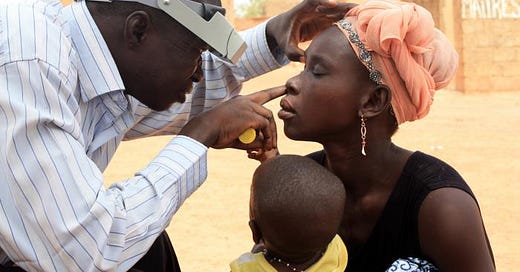Researchers from the Statens Serum Institut (SSI) and Imperial College London have now come a step closer to a vaccine against the highly contagious disease, trachoma, and have tested the vaccine on humans in a large trial - with promising results.
The results have just been published in the renowned journal Lancet Infectious Diseases.
"We have succeeded in finding a method that can create immunity in the eye with significant levels of the mucosal antibody IgA. It bodes well for eye infections such as trachoma, which affect many people every year, especially in poor countries," says senior researcher Jes Dietrich from SSI.
The participants in the experiment were healthy men and women aged 18 to 45 years. The vaccine was safe and all participants developed an immune response to it.
As it is a challenge to achieve immunity in the eye with traditional injection vaccines, researchers have invented a special method of vaccinating, called "prime/pull", where immunity is first created in the blood by an injection vaccine ("prime"), and then drawn to the eye with eye drops containing the vaccine antigen ("pull"). This means that the vaccine is a combination of eye drops and the traditional vaccine that is given intramuscularly.
"The prime/pull method may also be applicable to other mucous membranes, and one can therefore imagine that it can also be used in the development of a vaccine to protect e.g. the mucous membranes of the respiratory tract or intestine",
"This could lead us closer to a chlamydia vaccine that is able to protect both the genital tract and the eye against chlamydia. We are in the process of developing such a vaccine", says senior researcher Jes Dietrich.
The organism that causes trachoma is Chlamydia trachomatis serovars A-C. These types are different from the types of Chlamydia that commonly cause the sexually transmitted infection that is so prevalent here in the United States.
Not only is trachoma a health issue in Africa and the Middle East, but it is also endemic on the Indian subcontinent, Southeast Asia and China. Pockets of trachoma are seen in Latin America and Australia.
This is definitely a disease of the poor with poverty, poor personal hygiene and crowded living conditions being a few of the main factors contributing to its spread. It is also more commonly found in areas where the climate is dusty and dry.
The infectious agent is transmitted person to person through contact with eye or nasal discharges on fingers and indirectly through the use of contaminated items such as towels, pillows and clothes items like a mother’s shawl.
Flies are also a carrier of the contaminated discharge from person to person after feeding on the eye discharge of an infected person. In Africa and the Middle East, a specific specie of fly, Musca sorbens, is responsible for much of the spread.
Initially the infection resemble “pink eye” where there is inflammation of the eye, pain and sensitivity to light. Also the eye produces a watery discharge and the infection and inflammation resolves itself. The severity of trachoma is the result of frequent reinfection of the eye which over time causes scarring on the inner upper eyelid.
The resulting network of scarring over time causes an in-turning of the eyelashes (trichiasis) and entropian.
This results in a chronic abrasion of the cornea from the contact from the eyelashes. The scratching of the cornea also results in additional eye infections which in combination cause the cornea to turn opaque and blindness is the final result.





